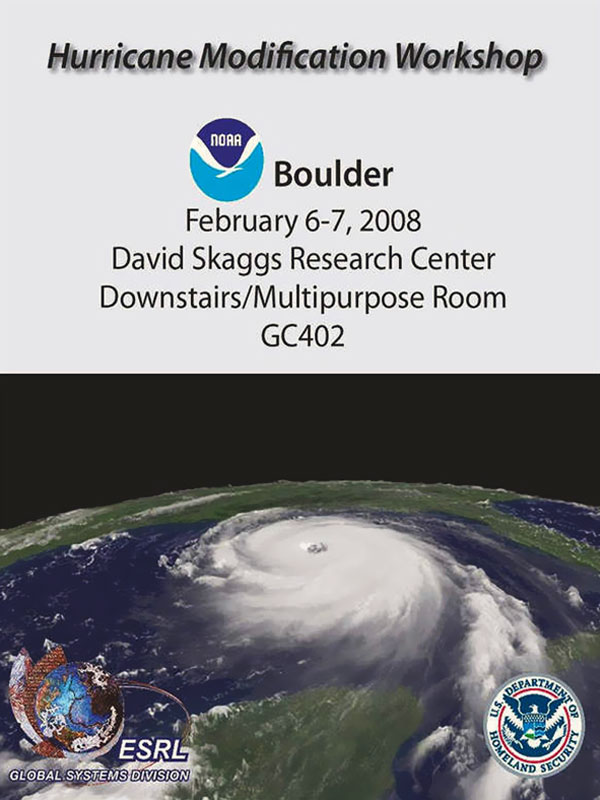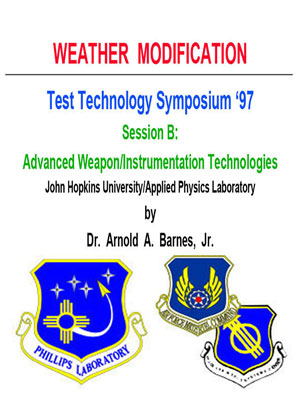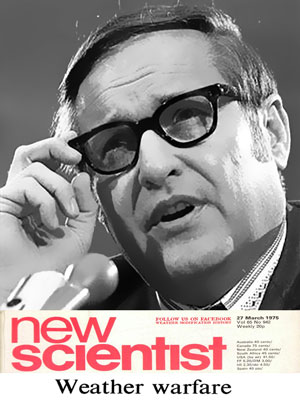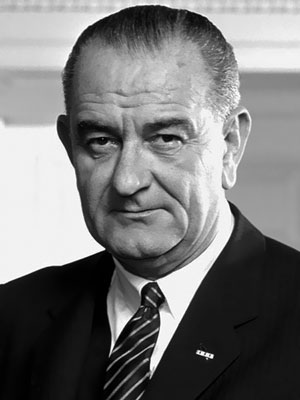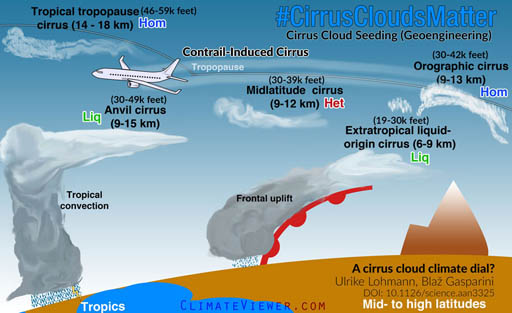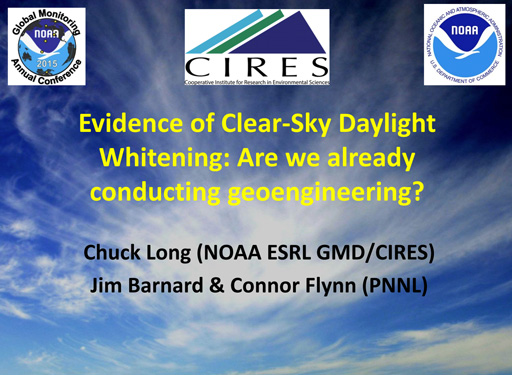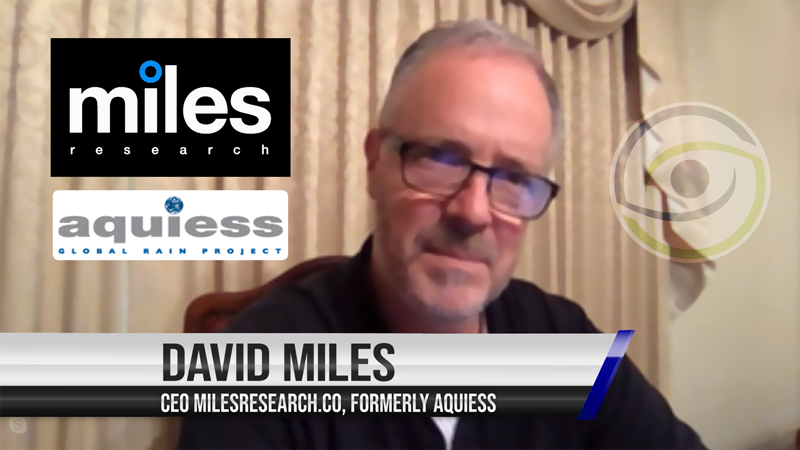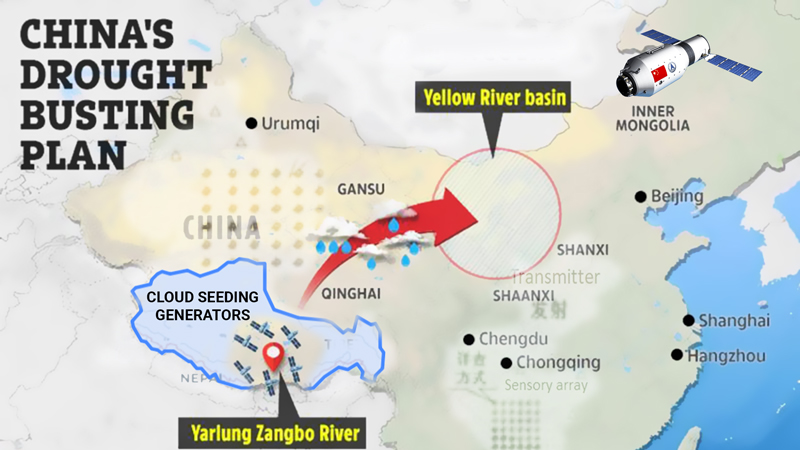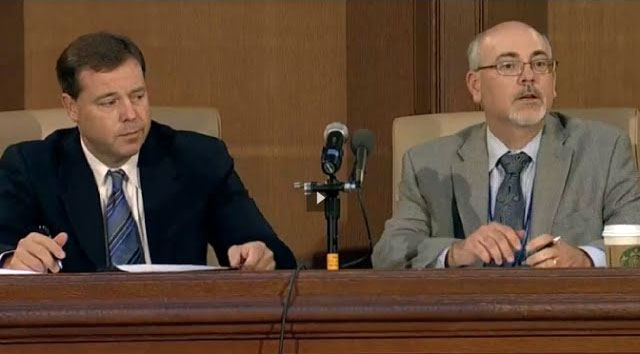
Cloud seeding is the most common form of weather modification currently employed globally. While I strive for this article to be all-inclusive, the topic of cloud seeding could (and will) take many articles to encompass fully. Please take the time to read and share this fascinating story of the little-known history of weather modification, and get involved in the debate by supporting our law, “The Clarity Clause.”
Notable Figures in Pluviculture (1800-1946 )

James Pollard Espy (or "The Storm King") (May 9 1785 – January 24 1860) was a U.S. meteorologist who proposed burning forests to increase rainfall. Espy developed a convection theory of storms, explaining it in 1836 before the American Philosophical Society and in 1840 before the French Académie des Sciences and the British Royal Society. His theory was published by in 1840 as The Philosophy of Storms. He became meteorologist to the War (1842) and Navy (1848) departments and developed the use of the telegraph in assembling weather observation data by which he studied the progress of storms and laid the basis for scientific weather forecasting.

It is not surprising that European American settlers in the Great Plains, dependent on agriculture and plagued by drought, would develop an interest in rainmaking. The earliest attempts involved the concussion method, which was premised on the theory that gunpowder explosions triggered friction and generated nuclei to produce rain. In 1890 Congress appropriated funds to put this theory into practice. The task was given to Gen. Robert St. George Dyrenforth. Experimentation began on the c Ranch in Andrews County, Texas, in1891 and continued at San Antonio, Texas, in 1892. No rainfall occurred. General Dyrenforth was dubbed "General Dryhenceforth," and the remaining funds appropriated for rainmaking experiments reverted to the Department of the Treasury.

The public did not give up on rainmaking. Frank Melbourne of Australia, the "rain wizard" who claimed to possess a "secret formulae" to produce rain, launched a successful career in Goodland, Kansas, in 1891. Although Melbourne guarded his techniques, other rainmaking companies soon claimed knowledge of his method. By 1892, the Goodland Artificial Rain Company and the Swisher Rain Company competed for business in South Dakota, Nebraska, Kansas, Oklahoma, Texas, Colorado, Utah, and California. By 1893, five rainmaking companies hailed from Kansas, all claiming use of Melbourne's method. Even then doubters were still in abundance across the Great Plains. Not much had changed since the early days of rainmaking: once while Melbourne was working in the Nebraska Panhandle, Old Jules Sandoz rode down to watch; following the performance that produced thunder, wind, and a few drops of rain complete with double rainbow, Old Jules remarked to his neighbors, "I'll keep catching skunks for a living." Eventually, fraudulent practices disillusioned farmers, and rainmaking companies lost support.

By the end of the nineteenth century, interest in irrigation had supplanted interest in rainmaking in Kansas. Still, Americans' faith in science and progress carried the rainmaker into the twentieth century. The cereal manufacturer, C. W. Post of Texas, maintained belief in the concussion method. From 1911 to 1914, Post executed "rain battles" near Post City, Texas, detonating dynamite along the Caprock Escarpment. Inspired by an occasional rain fall, Post optimistically predicted that rainmaking would one day replace irrigation.
By World War I, as public interest in traditional methods of rainmaking waned, scientists turned to airplanes and cloud seeding with sand, dust, and dry ice. This method used existing clouds, rather than the earlier attempts to create clouds, and met with some local success.
See also INDUSTRY: Post, C. W. April L. Whitten Omaha, Nebraska Mason, Basil John. Clouds, Rain, and Rainmaking. Cambridge: University Press, 1962. Spence, Clark C. The Rainmakers: American "Pluviculture" to World War II. Lincoln: University of Nebraska Press, 1980. Townsend, Jeff. Making Rain in America: A History. Lubbock: Texas Tech University Press, 1975. Source: Encyclopedia of the Great Plains
Charles Mallory Hatfield “Moisture Accelerator”
Native American, Rainmaker

In his free time, Charles Mallory Hatfield read about “pluviculture” and began to develop his own methods for producing rain. By 1902 he had created a secret mixture of 23 chemicals in large galvanized evaporating tanks that, he claimed, attracted rain. Hatfield called himself a “moisture accelerator”
The city of San Diego, suffering badly from drought, made a deal with Hatfield to make it rain. He agreed, and made it rain so hard there was flash flood, causing millions of dollars in damages. As a result,Hatfield was not paid, as this would imply fault on the part of the city. Ironically, this story is a microcosm of the weather modification industry. They want to be able to change the weather, but if the weather turns sour, they don't want to have to pay for the damages.
Charles Hatfield and the 1916 flooding at Lake Morena is the subject of the song Hatfield, a fan favorite of the southern jam band, Widespread Panic. Singer/guitarist John Bell wrote the song after reading the story of the rainmaker in a Farmers’ Almanac.
Hatfield (made rain for LA.) by Widespread Panic | Video LinkOde to Pluviculture
“The Rhyme of the Rain Machine” by F. W. Clarke, 1891
Said Jeremy Jonathan Joseph Jones “The weather is far too dry, So I reckon I’ll have to stir my bones And try the effect of concussive tones Upon the lazy sky.”
So Jeremy Jonathan Joseph went Away to the nearest town: And there his money was quickly spent For queer contraptions all intent To make the rain come down.
There were cannon, and mortars, and lots of shells, And dynamite by the ton; With a gas balloon and a chime of bells And various other mystic spells To overcloud the sun.
The day was fair and the sky was bright, And never a cloud was seen; When Jeremy Jonathan set alight His biggest fuse and screwed up tight The joints of the rain machine.
He fired a shot, and barely two, When the sky began to pale; The third one brought a heavy dew, But at the fourth tornadoes blew, With thunder, rain, and hail.
It rained all night and another day, And then for a week or more; It flooded the farm in a scandalous way, And drowned poor Jeremy, sad to say, Who Couldn't stop the pour.
O! Jeremy Jonathan Joseph Jones, Your farm was fair to see;But now a lake lies over its stones, From whose dark bosom horrific moans Are heard noctallee.
To check the flood you started, I've heard All efforts were in vain; Until the Bureau at Washington stirred, And stopped the storm with a single word, By just predicting - Rain!
Doing Something about the Weather
by: Victor Boesen
Man has always especially wanted to do something about rain. Too often there isn't enough rain. Of all the calamities which nature visits on the earth in the course of operating her weather machine-hurricanes, tornadoes, lightning, hail, floods-droughts are the worst.
Probably more millions have died of starvation for lack of rain that would nourish the crops than have died in all the storms of history put together.
In 436 B.C. thousands of Romans threw themselves into the Tiber rather than starve to death. The Bible tells how Joseph advised the Pharaohs on measures to relieve hunger in Egypt. In India, one year ten million people-one third the population of Bengal-died when the monsoon rains failed. Here in our own country we still remember the Dust Bowl years of the 1930's when the topsoil from millions of acres of Midwestern farmland blew away on the wind.
Nothing has changed. If anything, the specter of famine has increased. In 1974 nutritionists warned of "what may be the worst famine in the history of mankind" having begun with "between 30 million and 100 million people . . . now slowly starving to death . . . at least five million of then likely . . . to die this year."
The United States Weather Bureau, now the National Weather Service, once defined a drought as being when 21 days or more go by with only 30 percent of the rainfall normal for that time and place. In England an "absolute drought" is 15 or more rainless days in a row. Another measure of a drought is 85 percent or less of normal rainfall for the year.
By any of these measures there is always a drought going on somewhere. This means land is out of production, which could hardly be spared in any case. Only II percent of the earth's 3.5 billion acres is now considered suitable for crops
"Drought," says the Encyclopedia Britannica, "is the most serious physical hazard to agriculture in nearly every part of the world."
So it is that man has wanted to coax more rain from the passing clouds. In earliest times, when superstition ruled in matters of the unknown, he used magic in his efforts to turn the trick. In parts of Africa even today the rainmaker with his drums and other paraphernalia of his trade is a key member of his community.
The Indians practiced an assortment of rainmaking rituals. They smoked special pipes, burned tobacco by the stack. and shot arrows at the clouds-perhaps to spear the rain out of them. The Indians prayed, danced, and chanted. The Choctaws hung a fish around a tribesman's neck and stood him in the nearest stream until either it rained or somebody in authority came up with a good explanation of why it didn't.
If it chanced to rain in the wake of any of these proceedings the rainmaker got the credit. Who could say it wasn't he who did it-or would want to argue about it? If it didn't rain, it was remembered that last time it did. He couldn't be expected to score every time.
Professor James P. Espy, a pioneer authority on the weather, had noticed that thunderstorms and rain often followed a prairie fire or a forest fire. He therefore proposed in 1841 that forty acres of timber be burned every seven days at twenty mile intervals along a six-hundred-mile front from north to south on the western frontier of the country to put an end to drought.
During the Civil War it was noticed that it often rained in the wake of big battles. Several scientists thought smoke from the guns had something to do with it. To investigate this idea, Congress in 1890 put up $9,000 for rainmaking experiments with explosives.
One of the more colorful proposals to bring down the rain came from G. H. Bell of New York. He proposed building a series of towers 1,500 feet high-one set of towers to send saturated air up to cooler air and have the moisture condensed into rain, the other set to suck in rain clouds and store them for use as needed.
1916, Charlie promised to have the city reservoir filled and four feet of water going over the top of Morena Dam by January 27.
On schedule, smoke-or whatever it was-was seen coming from a tank on top of the twenty-foot tower the brothers had built near the reservoir, southwest of the city. Four days later, with the rain coming down as no one could remember it ever having rained before, the lake was up fourteen feet.
By the target date of January 27, instead of only four feet of water going over the dam, a Niagara roared over the top and matters were badly out of hand. Under the pressure of the racing flood, a dam downstream gave way, loosing disaster on the valley below. Twenty people drowned. Hundreds lost their homes. Damage was counted in the millions of dollars. The onrushing torrent ripped out scars on the hills and mountains which were still there years afterward.
If the mysterious "smoke" the Hatfields sent into the air from their little tower had anything to do with the rain that often seemed to follow, they may have been onto something without knowing what it was.
Every raindrop has a nucleus, a tiny speck of dust at its center like the stone in a peach. The air is filled with these particles. Even on the brightest day, when the sky appears to be immaculate, it contains particles, so small that they must be magnified thousands of times to be seen.
The particles come from many sources-salt spray from the oceans, from the soil, and from vegetation. They come from factory smokestacks, automobile exhaust pipes, jet air planes. They form on their own by chemical reaction in the atmosphere. "Condensation nuclei," weathermen call them.
Sharing the air along with these specks of dust is the moisture which the sun draws from the oceans and land surface; This is present in the form of vapor. When this condense on the nuclei, it forms droplets, themselves so tiny that it would take 2,500 of them, laid side by side, to reach on inch.
The droplets cluster around the dust specks like swarming bees, piling on top of one another. If conditions are right what they form may grow into raindrops. Where a little while before there was blue sky, there is now cloud. It may be "clouding up" to rain-or to snow if it's winter.
If the temperature of the cloud is below the freezing point of thirty-two degrees Fahrenheit, nothing may happen, no matter how many water droplets or how many dust particles are present. At any temperature below freezing the cloud is "super-cooled."
At five degrees, and not a moment before, the dust particles may start to take effect, causing the water droplets to begin to freeze, forming ice crystals. The cloud, in summer most often a cumulus, a word meaning "heap" or "mound, is seen ballooning skyward looking like a vast, dark cauliflower or the mushrooming dome of an atomic explosion.
Inside the cloud, the ice crystals are growing rapidly large as they collect droplets. In ten to twenty minutes, they are on their way to earth as snowflakes, growing still fatter as they bump into more droplets on the way down. They reach the ground as snow if it's freezing, as rain if it's above freezing.
This process of building ice crystals into snowflakes improves as the cloud builds and gets colder. It does best at about thirteen degrees below zero.
But if there is a shortage of dust particles in the rising air and the clouds aren't cold enough, nothing much happens. Don't expect either snow or rain, however promising the situation looks. Without the nucleating bits of dust, no ice crystals form, no matter how cold it gets.
One would think that after a while, as it keeps getting colder, the droplets would freeze on their own account. After all, water freezes at thirty-two degrees. Not so in this situation. The water stays liquid until it gets as cold as it is at the North Pole.
Finally, at around forty below zero, the little droplets give up at last and "flash over" into ice crystals-all of them, so that there are none left to make rain or snow. What we see then is cirrus, meaning "curl," those graceful, high-flying clouds with the shape of brush strokes and mare's tails.
It is clear that nature's processes for getting the water back down to earth once the sun has hauled it up into the atmosphere are not very efficient when measured by man's production standards. Even though generous amounts of vapor are condensed into droplets and then into drops, very little of the airborne water makes the trip to the ground.
Most of it turns back into vapor. Much of what does start down evaporates on the way. Studies of thunderstorms in the eastern United States show that only about twenty per cent of the condensed water in these storms ever reaches earth as rain. In the more arid regions of the country, such as the Great Plains, the clouds are usually so high up that most of their rain disappears on the way down.
Over our heads continually flow great rivers of water. Scientists estimate that these rivers carry six times as much water as those that flow on the ground. But these aerial rivers spill extremely little as they pass-less than one drop in ten.
There is, however, a way to make these sky rivers give up a little more water as they pass.
The nuclei that become the hearts of raindrops can be put into the rain-bearing clouds artificially. Several things may be used. By far the best is silver iodide. When vaporized, silver iodide yields about 600,000 billion particles per gram, each a potential raindrop. (There are 450 grams in a pound.) Only a few grams of silver iodide may affect many hundreds of cubic miles of cloud in a brief time.
Silver iodide provides a kind of tap for turning on the water in clouds where it's too warm for nature's own nuclei to be effective. Silver iodide begins to work when the tempera ture in the cloud is twenty-five degrees, whereas little happens with natural nuclei until the temperature is much lower.
Since most of the water is in the part of the cloud where silver iodide works-about three quarters of the cloud- silver iodide improves on nature's means for making rain.
The fateful secret of how to make the clouds give up water was discovered by accident.
1946 - The Birth of Cloud Seeding
Vincent Schaefer (1906–1993) discovered the principle of cloud seeding in July 1946 through a series of serendipitous events. Following ideas generated between himself and Nobel laureate Irving Langmuir while climbing Mt. Washington in New Hampshire, Schaefer, Langmuir’s research associate, created a way of experimenting with supercooled clouds using a deep freeze unit of potential agents to stimulate ice crystal growth, i.e., salt, talcum powder, soils, dust and various chemical agents with minor effect. Then one hot and humid July 14, 1946, he wanted to try a few experiments at General Electric’s Schenectady Research Lab. He was dismayed to find that the deep freezer was not cold enough to produce a “cloud” using breath air. He decided to move the process along by adding a chunk of dry ice just to lower the temperature of his experimental chamber. To his astonishment, as soon as he breathed into the deep freezer, a bluish haze was noted, followed by an eye-popping display of millions of microscopic ice crystals, reflecting the strong light rays from the lamp illuminating a cross-section of the chamber. He instantly realized that he had discovered a way to change supercooled water into ice crystals. The experiment was easily replicated and he explored the temperature gradient to establish the −40˚C limit for liquid water.

Current Methods of Cloud Seeding
This section is broken into two parts: Ground-Based and Airplane-Based.Ground Based Seeding:

Mountain Skywater - Colorado River Basin Cloud Seeding Pilot Project - 1981 Video Link




Snowy Hydro – Cloud Seeding 2009 Video Link watch “3:43″
Airplane Based:

The Rainmakers Video Link



Chemicals and Methods used in Cloud Seeding
In the United States of America, you are required by Pub. L. 92-205; 15 CFR part 908 to report any weather modification activities to the National Oceanic & Atmospheric Administration (NOAA). The following forms are required by law:- NOAA FORM 17-4 - Initial Report on Weather Modification Activities
- NOAA FORM 17-4A - Interim Activity Reports and Final Report

Under the section “Type and Amount of Agent Used” we find the following choices:
- Silver Iodide
- Carbon Dioxide
- Urea
- Sodium Chloride
- Other
Carbon Dioxide (CO2) cloud seeding refers to the use of Dry Ice.

Urea CO(NH2)2, the main ingredient in fertilizer and urine, is described in detail in this 1966 paper from the American Meteorological Society: “Urea as an Ice Nucleant for Supercooled Clouds”

Sodium Chloride (NaCl, table salt), or calcium chloride (CaCl) is the active ingredient in warm cloud seeding. Sea salt is also a cloud seeding agent used in “Albedo Enhancement” and “Cloud-brightening” experiments, like: The Silver Lining Project: Cloud-making boats, ocean pumps to halt hurricanes?

The Silver Lining / Marine Cloud Brightening Project | Video Playlist
Now we have come to the “Other” section. Let’s focus on Carbon Black:
Carbon Black C(soot) is a cloud seeding agent used by the USAF and aviation pollution (contrail-induced cirrus clouds) performs inadvertent cloud seeding. Commercial airline soot also aggravate hurricanes as mentioned in:
- American Chemical Society 1958 "Carbon black cloud seeding makes weather to order"
- William M. Gray , William M. Frank, , Myron L. Corrin, and , and Charles A. Stokes, Atmospheric Science Department, Colorado State University, Ft. Collins 80523 1976 "Weather Modification by Carbon Dust Absorption of Solar Energy"
- Phillips Laboratory (AFMC) Geophysics Directorate, Author Uknown, 1994? Weather Modification Using Carbon Black
- Col Tamzy J. House, Lt Col James B. Near, Jr., LTC William B. Shields (USA), Maj Ronald J. Celentano, Maj David M. Husband, Maj Ann E. Mercer, Maj James E. Pugh, 1996 "Weather as a Force Multiplier: Owning the Weather in 2025" USAF 2025
- Dr. Arnold A. Barnes, Jr., Optical Effects Division, USAF Phillips Laboratory, 19 March 1997 "TEST TECHNOLOGY SYMPOSIUM ’97, WEATHER MODIFICATION"
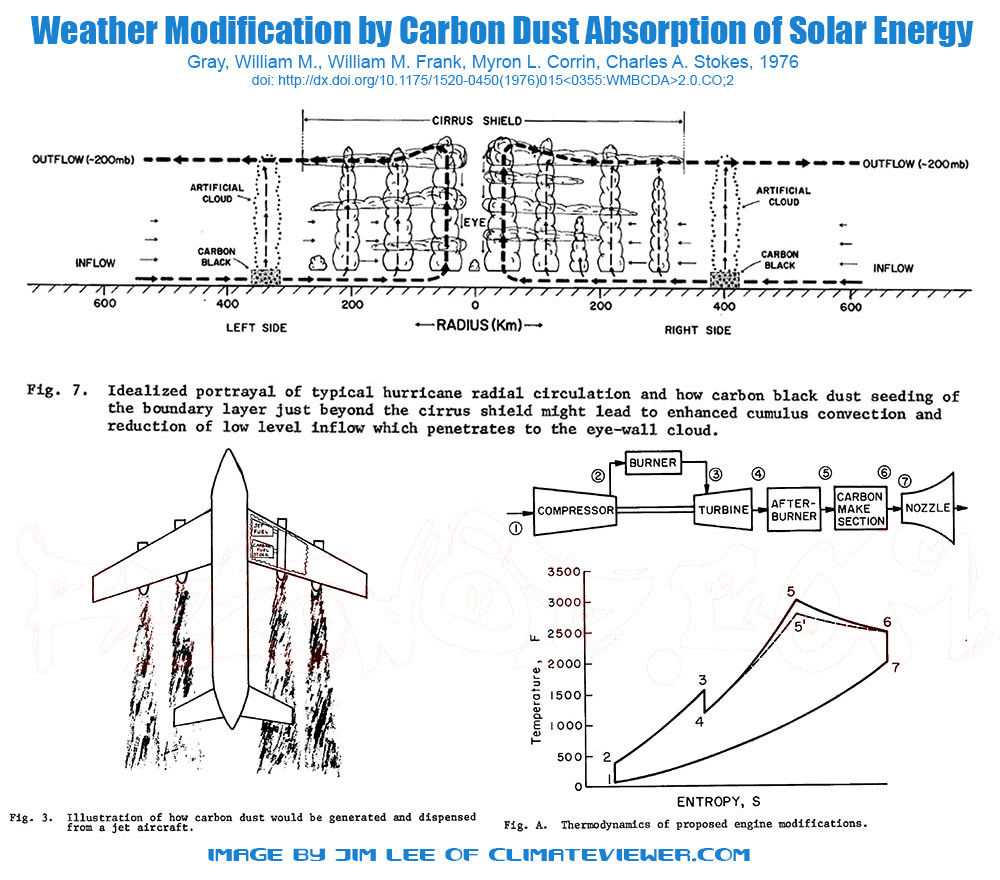




Does Cloud Seeding Work?
Yes and no:Despite the American Meteorological Society, World Meteorological Organization, and the National Research Council’s National Academy of Sciences Board on Atmospheric Sciences and Climate stating clearly that weather modification is still unproven science and that large scale experiments should be limited to modelling, the geoengineering community pushes ahead with their re-branded weather modification techniques:
"Although 40 years have passed since the first NAS report on weather modification, this Committee finds itself very much in concurrence with the findings of that assessment... We conclude that the initiation of large-scale operational weather modification programs would be premature. Many fundamental problems must be answered first. It is unlikely that these problems will be solved by the expansion of present efforts, which emphasize the a posteriori evaluation of largely uncontrolled experiments. We believe the patient investigation of the atmospheric processes coupled with an exploration of the technological applications may eventually lead to useful weather modification, but we emphasize that the time-scale required for success may be measured in decades."National Science Foundation - Critical Issues in Weather Modification Research (2003)
“It was concluded that tests conducted so far have not yet provided either the statistical or physical evidence required to establish that the seeding concepts have been scientifically proven.”
“It should be realised that the energy involved in weather systems is so large that it is impossible to create cloud systems that rain, alter wind patterns to bring water vapour into a region, or completely eliminate severe weather phenomena. Weather Modification technologies that claim to achieve such large scale or dramatic effects do not have a sound scientific basis (e.g. hail canons, ionization methods) and should be treated with suspicion.Purposeful augmentation of precipitation, reduction of hail damage, dispersion of fog and other types of cloud and storm modifications by cloud seeding are developing technologies which are still striving to achieve a sound scientific foundation.”
World Meteorological Society - Executive Summary of the WMO Statement on Weather Modification
“In 2004, in light of the findings of the National Academy of Science (11), the EAA considered eliminating funding for cloud-seeding, but eventually included $153,520 in their 2005 budget for cloud-seeding flights and an independent evaluation of previous efforts (12).In 2007, the EAA approved cloud seeding efforts for the ninth year in a row, and for the first time the program included a method to statistically evaluate the project’s effectiveness. Four Board members voted against continuing the program, saying there was evidence that cloud seeding could actually decrease rainfall by accident, and they also had concerns about the EAA paying for scientific studies to investigate something the National Academy had already concluded doesn’t work.
In January of 2012, Dr. Roelof Bruintjes from the National Center for Atmospheric Research made a presentation to the EAA in hopes of building support for a research project to further investigate the effectiveness of cloud seeding. Dr. Bruintjes contended that new radar and satellite technologies and new airborne instruments could be used to quantify the effects of cloud seeding techniques. The EAA declined to fund the study, but continued to fund its own precipitation enhancement efforts with $150,000 in its 2013 Operating Budget.
The latest version of the Texas State Water Plan issued in 2012 estimates that by 2060, weather modification could account for only 0.2% of the State’s water needs (15).
Conclusion
Cloud seeding is big business now with insurance companies and stock market derivatives now involved in controlling our dwindling water resources. China, Russia, and many other countries have national weather modification programs that alter the skies on a daily basis, and there are no laws protecting you.The business of controlling our weather is secretive, unregulated, and in need of a big change:
The Clarity ClauseA draft legislation to end atmospheric experimentation without notification: CLICK HERE







